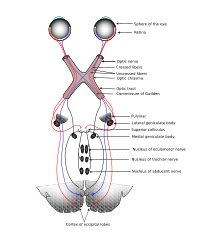
Photo from wikipedia
Bio-mimetic approaches to restoring sensory function show great promise in that they rapidly produce perceptual experience, but have the disadvantage of being invasive. In contrast, sensory substitution approaches are non-invasive,… Click to show full abstract
Bio-mimetic approaches to restoring sensory function show great promise in that they rapidly produce perceptual experience, but have the disadvantage of being invasive. In contrast, sensory substitution approaches are non-invasive, but may lead to cognitive rather than perceptual experience. Here we introduce a new non-invasive approach that leads to fast and truly perceptual experience like bio-mimetic techniques. Instead of building on existing circuits at the neural level as done in bio-mimetics, we piggy-back on sensorimotor contingencies at the stimulus level. We convey head orientation to geomagnetic North, a reliable spatial relation not normally sensed by humans, by mimicking sensorimotor contingencies of distal sounds via head-related transfer functions. We demonstrate rapid and long-lasting integration into the perception of self-rotation. Short training with amplified or reduced rotation gain in the magnetic signal can expand or compress the perceived extent of vestibular self-rotation, even with the magnetic signal absent in the test. We argue that it is the reliability of the magnetic signal that allows vestibular spatial recalibration, and the coding scheme mimicking sensorimotor contingencies of distal sounds that permits fast integration. Hence we propose that contingency-mimetic feedback has great potential for creating sensory augmentation devices that achieve fast and genuinely perceptual experiences.
Journal Title: Scientific Reports
Year Published: 2017
Link to full text (if available)
Share on Social Media: Sign Up to like & get
recommendations!